The All American Sun Oven
https://www.sunoven.com/
This story is best told as a story. I didn’t believe at first that this oven would really work. Anyone can game Youtube videos to make a product look good, and I just assumed that the All American Sun Oven was just another gimmick being sold to preppers. First of all, I live in South Florida. If a sun oven is going to work anywhere, it is going to work here. But I had never heard that such a thing was possible. I could see a huge dish, focusing the sun’s rays on an egg or something. But to get enough consistent heat to cook a chicken, or even a loaf of bread? Not so much. Not a reality. Boy was I wrong. I don’t know how the All American Sun Oven works up in snow country, but there is no reason to think that a sunny day anywhere can’t cook food just like a regular oven. You do have to move the oven around some, but at $399 for a complete survival kit, nobody who has stored freeze dried foods and pantry staples should be without one. No fuel? No problem. The All American Sun Oven works.
That isn’t to say that I didn’t feel like an idiot when I began the tests. After initially reading up on the All American Sun Oven, before opening the box, I wanted to believe it worked. But when I told friends and co-workers that I thought it could be a decent product, every single one of them had something negative to say.
“I tried that in Boy Scouts it doesn’t work.”
“You don’t think that’s really going to work do you?”
“Those things don’t work. You shouldn’t waste your money”
So I started to question the oven’s potential, though I had developed high hopes for it after my initial research. I personally had been skeptical myself, but everyone else just took the wind out of my sails.
Sooooo… I procrastinated for several months, until one day last week I was in Walmart and decided to buy some frozen loaves of bread dough. No way was I actually making dough for what was most likely going to be a failed experiment. I followed the directions on the package, and the dough was ready to go the next day.
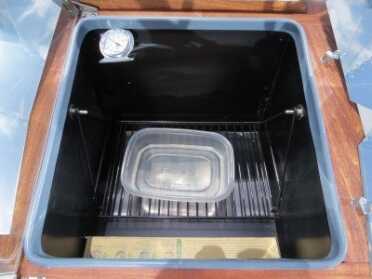
The levelling rack works really well so even if the oven is tilted, liquid is fairly level. This is the vinegar.
Day 1 The All American Sun Oven

Both days we tested the sun over it was only partially sunny. Rarely did the sun shine for more than 15 minutes at a time.
From the very start on day 1, I screwed up. Usually I let dough rise twice, punching it down in between, but apparently store-bought frozen dough doesn’t have the veracity to withstand such punishment. So even though the dough didn’t rise much the second time, I unpacked my Sun Oven. It is made from a plastic housing, with a gasket on the top opening and glass window on a hinge. The glass window locks down with two rotating levers. Around the plastic container, you fold out leaves of thin metal. They come with a blue plastic adhered to the tops, so before you get to test your sun oven, you have probably 20 minutes of peeling to go through. Fair warning: if you pick a nice day in the sun to test your Sun Oven, peel inside. Then, as I’m unpacking the box, I read a pink sheet of very “emergency” looking paper, printed with instructions to first boil vinegar inside the sun oven, then wipe out the insides with the vinegar. Why do I have to do that? It doesn’t say! What if I didn’t have vinegar? My guess is that it has something to do with the gasket material leaking fumes or something, so, because I was not in a survival situation and did happen to have some vinegar, I followed the directions. Two demerit points though, for the blue film and the vinegar.
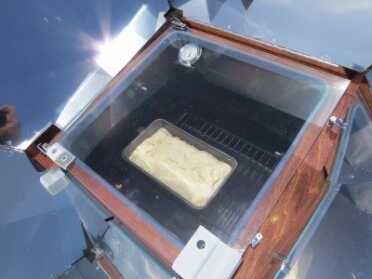
Day 1 loaf of bread. I punched it down thinking it would rise again like homemade, but it only rose a second time a bit.
My next screw-up came by not making sure that the glass lid was secured down. I started my test around noon, and within twenty minutes or so the temperature of the oven got up past 212, the boiling point of water. This was really impressive, because I keep a lot of freeze-dried food, as well as pasta, rice and beans. Boiling water is all you need for all of them, and this was great news. The oven, however, advertised temps twice that and I really wanted to see that happen and to bake my bread. The day got more cloudy though, and I couldn’t seem to get the oven above 275. You can cook most stuff at that temp, so I figured I’d put the bread in and see what happens. By then I was up to mostly cloudy conditions, with blips of sun lasting less than 2-3 minutes. Because conditions weren’t ideal, I didn’t go out to turn the oven that much, because you need full sun to line up the built-in centering guides. Three hours later, the bread was cooked, but not browned. Ugly, but edible.
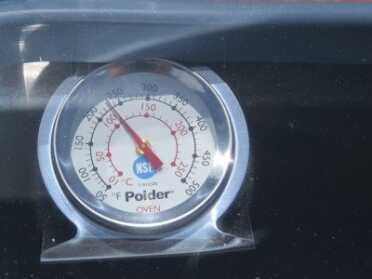
Even in short bursts of sun the oven quickly reached well above 212 degrees, making it ideal for heating water to re-hydrate freeze dried foods. It was tough to get it over 275 though.
Imagine my shock when, as I removed the bread, I realized that the glass was not sealed. There are two flip levers that you turn to keep the glass down, and they came tightened down a little too tight. But instead of getting a screwdriver and loosening them a bit, I had lazily just hooked one on the corner, which was tight, but not secure. At some point during the day, while I was turning the oven, it had let go, and I was not aware that my test of the sun oven was a failed test, not a failed oven. That night I took another frozen dough ball out of the freezer to defrost for the next day. It is only fair to do a real test.
Day 2 – The All American Sun Oven
On the second day I didn’t punch the dough down, but it started out discouraging nonetheless. The sun wasn’t out, and the clouds seemed to be worsening. Even with the glass secured this time, the oven barely made it past 250 degrees. I really wished that I had chosen to test the oven on one of our many fully sunny days here in South Florida. This was really frustrating.
Then I realized that this is the story of the All American Sun Oven. I’m quite sure that it is capable of reaching 450 degrees under ideal circumstances, but how often does that happen in life? I wanted to get this article done for this week, not a survival situation, but it did have that component of survival that ideal circumstances aren’t just something you can wait for. You make do with what you have. On an overcast day, the sun oven will most likely still get past 212 if you turn the oven for an hour (not easy without good shadows). It will melt snow for water in the cold climates, and it might even boil on a sunny day in sub-freezing temps. This is a great survival tool, and anyone who is storing food should not be without it.
So how did the fully cooked loaf of bread here in the pictures come about? Funny story. I again put the risen loaf into the oven at just over 250 and diligently turned the oven into the sun every half hour or so. The oven comes with a leg that raises and lowers it to face the sun on an angle. The two centering circles are really easy to use, but because the sun just wouldn’t stay out, at first the bread only cooked, but didn’t brown. One last time I turned the oven, just as the sun came out from behind the clouds. It looked like a great sun window, but because I had already given up, I didn’t even think to check the bread again. Later, when I went out to put away the oven, the bread was browned, and perfectly cooked. I never did get to see how hot the oven would get, but it made a perfect loaf of bread. Stay tuned!


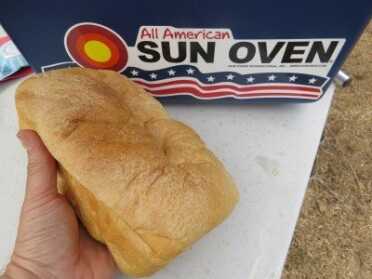
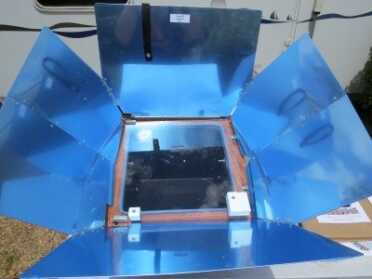
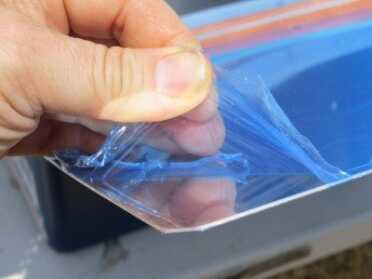
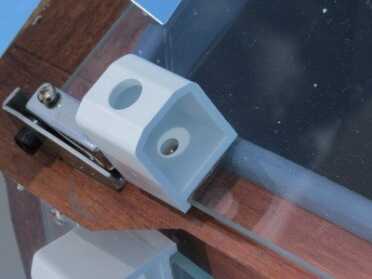
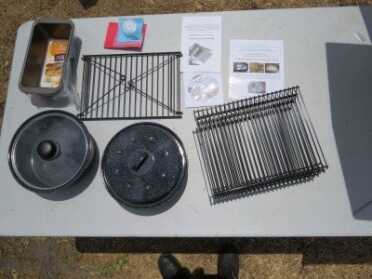
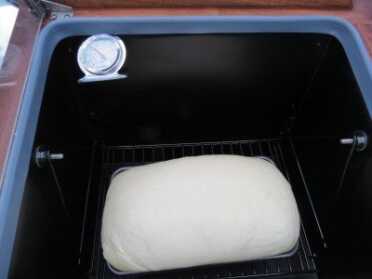
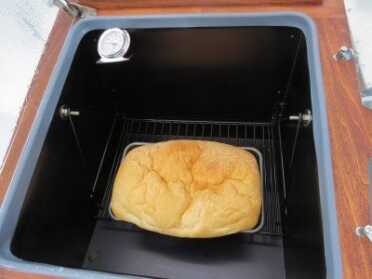
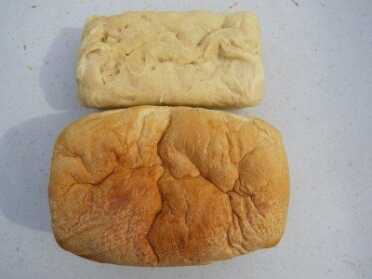
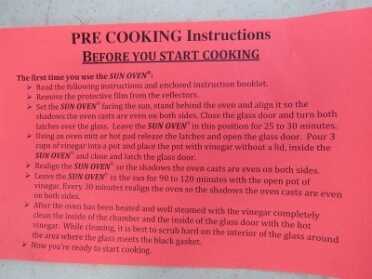
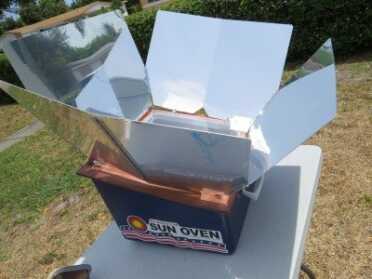
My main question is do you have to clean it every single time with the vinegar mix? After all you are basically resealing the oven for storage similar to the way it was shipped and if it is do to fumes being leached by the gasket then wouldn’t that continue and need to be cleaned again? Another question is how sturdy is the oven? You stated it was thin sheet of metal so how easy would it be to accidently deform them to the point he oven may not work for you?
No I don’t think so. It doesn’t say that. My guess is that it bleeds some chemical out of the rubber seal.
I would rather read/hear about the screw ups and difficulties in a test than to have something presented as the best thing since burnt toast. As humans we make mistakes and, occasionally, do not follow directions. How products perform under un-ideal conditions makes them demonstrate their real value.
I, for one, really appreciated the article and the honesty that came with it. Thank you.
Obviously the “blue film” is necessary to protect the mirrors. Why would you give the oven a demerit for that? It can’t be omitted. I guess you expect the manufacturer to come peel it for you?
For four hundred bucks yea. I actually bought two of them by mistake in Amazon, so a total of $800.
I have a similar oven (different brand) and when the scruffy bunch I hang with decided to go to Mojave for the weekend last summer, I brought my sun oven along. Day one, it roasted a 5 pound beef roast (in a glass roaster bottom) with potatoes, mushrooms, carrots and onions in a red wine sauce. Dinner was… Well, my new nickname is “Chef Mack”. Day two, I decided to try bread. I forgot to watch the temperature ( the air was in the 90’s). This oven gets hot enough to not only bake bread, but to set it on fire if you don’t pay attention to it.
So in a word, these ovens work. They’re perfect for cooking, purifying water, drying meat, and occasionally providing the evening’s campfire-starter. I do like the orientation gizmos, since mine has a stick that you have to adjust so it casts no shadow. Also, what isn’t mentioned is that you do occasionally need to re-position the oven for even temperature. That’s also a good time to make sure your meal isn’t on fire.
This article would have been much more useful if the test was also performed under ideal conditions. And tested on meat rather than bread. Please consider updating or running a second article with more complete results.
to be continued
I would agree with the posting about making your own, however, the tools to craft a clone of this All American Sun Oven and the time with materials would actually cost more in the long run. There are youtube vids on making your own, but you would need to babysit those more frequently. Up here in TN, the oven is great from March until October with little involvement to keep things going. I had bought a small wooden cart dolly with caster wheels to easily rotate the unit as the earth turns to the sun. Turning on a summer day is once per hour. The early Spring or late Fall, every 30 mins. Next to a rocket stove, this is very practical. I love the food dehydrator the Sun Oven provides. Try doing that well in a DIY made unit that needs constant monitoring. The Sun Oven does this really well. Beef jerky or sizzeled bacon is great. Just keep a tray below for any drippings. This Sun Oven folds up really well into a nice carton. Placing this on a small laugage hand cart with wheels makes this very portable. If the daylight is too sunny, a screen mesh can reduce the overheating or turn the unit away from the direct sunlight a little. This unit will cook a whole chicken, a lasagna tray, cookies, bread, soup, coffee, stew, baked potates, corn bread, etc. Done dehydrated apples, apricots, bananas and other items too. Due note, when working with ANY solar oven, have a good pair of SUN GLASSES. Looking into these Sun Ovens can blind your vision while trying to place a pot or cooking tray into them. That’s my only other recommendation.
WOW! Pretty cool article! I may have to keep an eye out for this product at my usual sources. Maybe Sportsman’s Guide will stock this thing, if not already. If a person were also a astrophysics amateur, I can see where you could use your telescope motor to keep this thing pointed at the sun without having to check it manually. COOL! Excellent pictures, thanks for the article!
A lot of people would be surprised how many of these things are used in other parts of the world.
I’ve played with these to some extent and they do work in the winter time. Maybe a little slower coming up to speed but then, there is such a thing as ‘slow cooking’??
This one really has some good thinking put in it and certainly is the Mercedes Benz of solar ovens but for that price it should at least charge your cell phone while you cook dinner, like that ‘biolite’ (i think) gassifier stove.
Bbut if you search around there are cheaper ones that do just as well, and of course you can make your own for next to nothing.